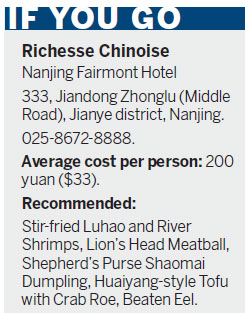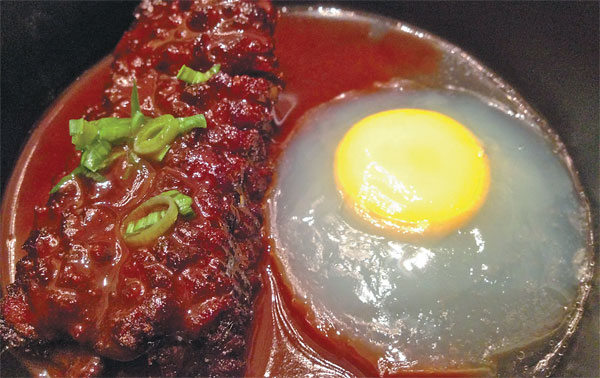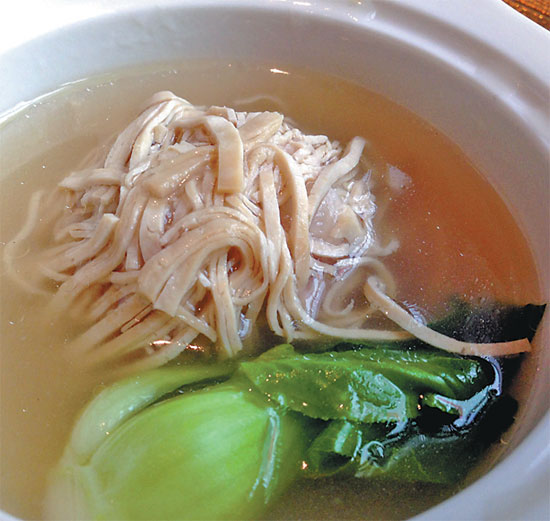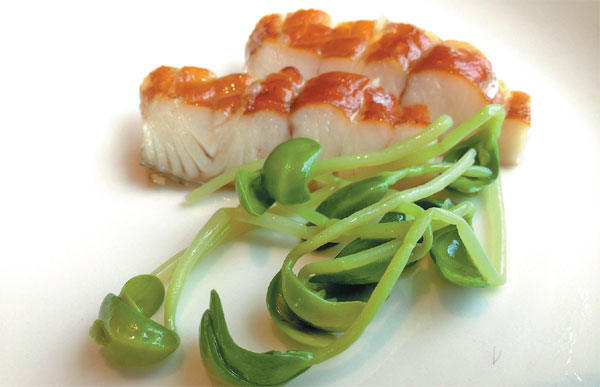An ode to good food
Updated: 2014-02-23 06:47
By Pauline D. Loh(China Daily)
|
|||||||
|
Finger-sized river eels are filleted and beaten with a rolling pin to tenderize the meat. They are braised in a sweet and savory sauce. |
|
This tender meatball is shrouded in beancurd juliennes, adding to the illusion that it is a lion's head. |
|
At Richesse Chinoise, subtly smoked fish is paired with sprouts grown from black beans. Photos by Pauline D. Loh / China Daily |
Fresh flavors and artful kitchen skills combine to make the food of the Yangtze region a universal favorite even among Chinese gourmets stubbornly faithful to their home cuisines. Pauline D. Loh explores the reasons why.
There is a vegetable that grows along the rivers and lakes in Jiangsu that makes grown men cry when they remember its taste. It is a weed, a species of mugwort that used to grow wild abundantly, but is now mostly cultivated.
Luhao, or water Artemisia, is valued for its sweet crunchiness. Only the stems are used, and they are stir-fried, usually with delicate batons of the region's equally famous five-spiced hard beancurd.
Some have compared the taste of luhao to asparagus, only immensely more subtle.
Subtlety is a signature of Huaiyang food as the collective cuisine of the region is known, and luhao is only one of the many ingredients that reflect this style of eating and cooking.
At Richesse Chinoise, the Chinese restaurant in the Fairmont Nanjing, the Huaiyang chefs pride themselves in continuing the tradition of using only the freshest, seasonal ingredients. They took me to market to show me exactly how much it mattered.
Chef Meng Xianfeng is an experienced Huaiyang chef schooled in the traditional kitchen and his eagle eye roamed over the gathered produce with radar precision.
We visited shops offering tubs of wriggling river eels, and he tells me what is best for which dish. There are fresh abalones, sea cucumbers and huge river clams to make a milky sweet broth, bullfrogs that weigh in at about a kilogram each, and fishes like the ubiquitous crucian carp, snakehead and the much rarer and more expensive mandarin fish.
What caught my eye were tiny transparent crustaceans, which Meng says are the white lake or river shrimps, something else my colleagues from Jiangsu had spoken of with great longing.
It was at the vegetable section that Nanjing showed off its best produce. There was such a lot of green that it made me misty-eyed thinking of the pale winter cabbages and radishes of Beijing.
Among the green, though, were the lighter-colored water Artemisia, piled high like very slender asparagus everywhere. Meng tells me those with the red-tinged roots are wild, and they cost about twice as much as the cultivated vegetables.
Back at the restaurant, Meng and Chinese master chef Ken Luan set to work turning our day's marketing into an exceptional lunch.
First up was a bowl of clear broth in which sat a giant meatball. It wore a mane of shredded beancurd skin, and I realized I was looking at the famous "lion's head".
This is nothing like the red-braised meatballs north of the Yangtze, deep-fried and brown-braised and shrouded with a sticky brown sauce, heavily scented with star anise.

The Nanjing version is light as Tinkerbelle's touch, melt-in-the -mouth tender and held together by kitchen magic. It is also a showcase of the chef's skill. Lean meat with just a modicum of fat is hand-minced and then repeatedly slapped against the side of a bowl until it binds.
The meatball has the texture of tofu and is white with the natural protein released in the cooking.
Master chef Luan places a platter of smoked fish on the table and says it's a "little appetizer". The slices are tender and savory and the palate is awakened by the oddly sweet smokiness of the skin. Accompanying the fish is a pile of bright green sprouts, which the chef says are grown from black beans.
It was the next dish, however, that captured my total attention.
The presentation was nothing fancy and it looked like a stir-fry Mama can turn out in her kitchen, but the first taste told me different.
Lengths of water Artemisia, stripped clean of any leaf, had been simply tossed with the little lake shrimps. This is my second day in Nanjing, and already my palate was luxuriating in the all-natural sweetness of Nature's bounty. The shrimps exploded in the mouth like puffs of sugar, and the vegetables added crunch that neither overcame nor was overwhelmed.
I am ashamed to say that though other dishes came in quick succession, my chopsticks kept going back to the luhao and shrimps. It was the only clean plate sent back to the kitchen that afternoon.
During our marketing, Meng had bought a curious bunch of vegetables that I thought had a familiar floral scent. He served this up next in a very light soup, and contrasted the dark deep green with an egg drop using only the white.
This is what the Nanjing folks call chrysanthemum leaves, and it is indeed a relative of the flowering variety. The very aromatic leaves had a pleasantly pungent scent and worked well as a palate cleanser after the intense pleasure of the shrimps.
Finally, the chefs presented a simple cake made from two types of rice flour, the usual white rice and darker, deeper purple rice. Again, subtlety is the key word, and the smidgen of lotus paste hidden in its heart was all that was needed to complete the epicurean treat.
In another meal in the same restaurant, executive chef Samson Sun, a native Beijinger, proudly showed off his skills with another dish - beaten eel.
Translated, the name of this dish loses much of its lyricism and acquires an unwarranted exoticism. In truth, eels are very commonly eaten here, and provide much of the protein in the diet.

They are plentiful, easily caught and raised and are another signature in the regional cuisine.
Beaten eel is a deboned fillet that is laid flat on the chopping board and beaten with a rolling pin to tenderize the flesh. The fillet is braised, mainly to get rid of the fishy taste. The result is a fish roll, tender at first bite, and then chewy when you reach the skin.
At Richesse Chinoise, the beaten eel is served with a dove egg, its white translucent and serving as a contrast to the eel's dark meat.
If you only had one chance to eat Chinese, search out Huaiyang cuisine. It combines the best of northern and southern styles and in Nanjing, few places serve it better than the Richesse Chinoise.
Contact the writer at paulined@chinadaily.com.cn.
(China Daily 02/23/2014 page7)


